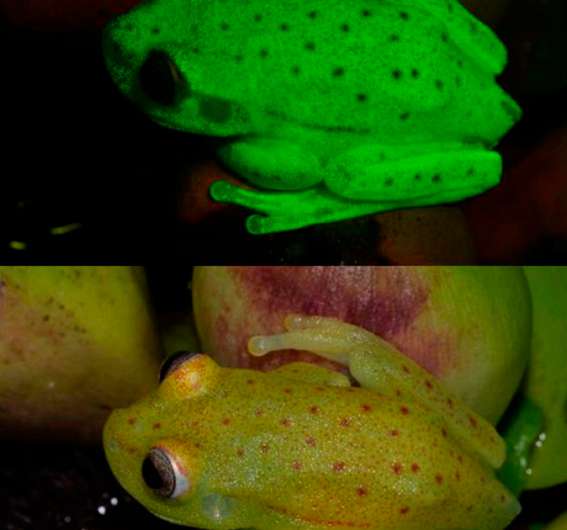March 14, 2017 report
Naturally fluorescent amphibian found in Amazon basin

(Phys.org)—A team of Brazilian researchers has found a naturally fluorescent tree frog living in the Amazon basin and it represents the only known fluorescent amphibian. In their paper published in Proceedings of the National Academy of Sciences, the team describes their study of the frog, their surprise at finding it was fluorescent and their plans for further study to learn why it has such a remarkable feature.
The most commonly known application of fluorescent material is the paint used on posters that glow brightly when exposed to a black light. In the natural world, fluorescence is observed in a variety of ocean creatures, including sharks, corals and sea turtles—and in a few land animals such as scorpions and parrots. Also, fluorescence is not the same as bioluminescence—fluorescent creatures do not generate the light via chemical reactions; instead, they have skin that is able to absorb short wavelength light and re-emit it as longer wavelength light.
In studying the tiny frog (the South American polka dot tree frog— Hypsiboas punctatus), the researchers found a skin pigment they thought might result in fluorescence, so they pointed a black light at it and found the frog changed from a dull yellow color with red spots to a neon green frog with dark spots. Surprised by their finding, the researchers conducted a thorough investigation of the little amphibian's skin. In so doing, they discovered three molecules, hyloin-L1, L2 and G1. Each has a ring and a hydrocarbon chain, which, the researchers note, is unlike known molecules that cause other creatures to be fluorescent. They also found that the molecules allowed for emitting a lot of light, approximately 18 percent as much as moonlight.
The researchers do not know why the frogs are fluorescent, and they note the frogs have not been subjected to much prior study, which means there is a lot to learn. They plan to study photoreceptors in their eyes to find out if the frogs use their fluorescence to better see one another at night. They also plan to take a closer look at other tree frogs in the area to see if they, too, may have the same feature.
More information: Naturally occurring fluorescence in frogs, PNAS, www.pnas.org/cgi/doi/10.1073/pnas.1701053114
Abstract
Fluorescence, the absorption of short-wavelength electromagnetic radiation reemitted at longer wavelengths, has been suggested to play several biological roles in metazoans. This phenomenon is uncommon in tetrapods, being restricted mostly to parrots and marine turtles. We report fluorescence in amphibians, in the tree frog Hypsiboas punctatus, showing that fluorescence in living frogs is produced by a combination of lymph and glandular emission, with pigmentary cell filtering in the skin. The chemical origin of fluorescence was traced to a class of fluorescent compounds derived from dihydroisoquinolinone, here named hyloins. We show that fluorescence contributes 18−29% of the total emerging light under twilight and nocturnal scenarios, largely enhancing brightness of the individuals and matching the sensitivity of night vision in amphibians. These results introduce an unprecedented source of pigmentation in amphibians and highlight the potential relevance of fluorescence in visual perception in terrestrial environments.
Journal information: Proceedings of the National Academy of Sciences
© 2017 Phys.org



















